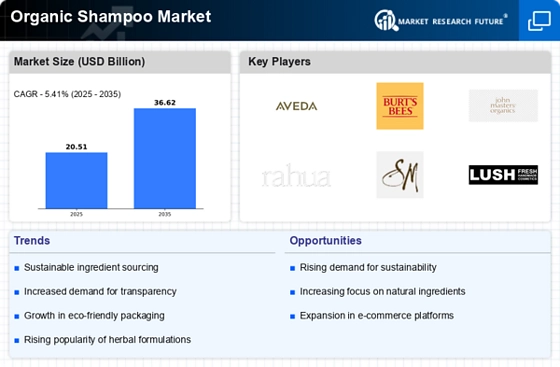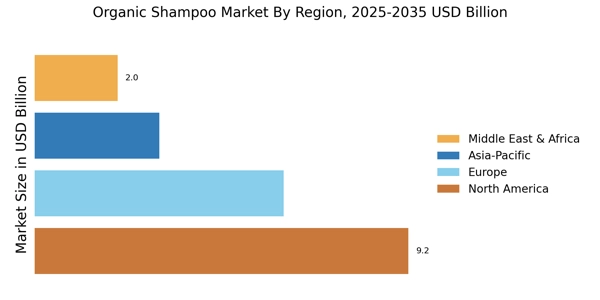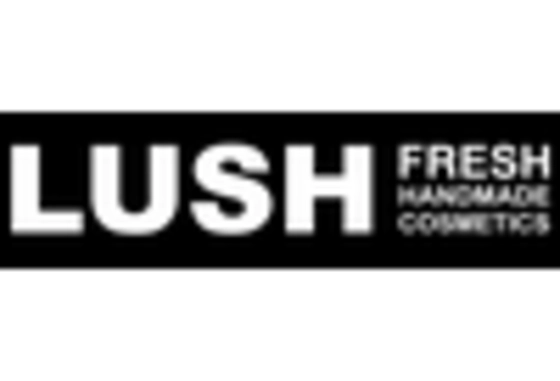Influence of Social Media
The influence of social media is profoundly impacting the Organic Shampoo Market. Platforms such as Instagram and TikTok have become vital channels for brands to engage with consumers and promote their organic offerings. Influencers and beauty enthusiasts frequently share their experiences with organic shampoos, creating a ripple effect that drives consumer interest and purchasing behavior. Market data indicates that brands leveraging social media marketing strategies are experiencing a sales boost of up to 20%. This trend underscores the importance of digital presence in reaching target audiences and fostering brand awareness. As social media continues to evolve, it is expected that its role in shaping consumer perceptions and preferences within the Organic Shampoo Market will only intensify.
Rising Consumer Awareness
The Organic Shampoo Market is experiencing a notable surge in consumer awareness regarding the benefits of organic products. As individuals become more informed about the harmful effects of synthetic chemicals found in conventional shampoos, they are increasingly opting for organic alternatives. This shift is reflected in market data, which indicates that the organic personal care segment is projected to grow at a compound annual growth rate of approximately 10% over the next five years. Consumers are actively seeking products that align with their health and wellness values, driving demand for organic shampoos that are free from parabens, sulfates, and artificial fragrances. This heightened awareness not only influences purchasing decisions but also encourages brands to innovate and expand their organic product lines, thereby contributing to the overall growth of the Organic Shampoo Market.
Health and Wellness Trends
The growing emphasis on health and wellness is significantly influencing the Organic Shampoo Market. Consumers are increasingly prioritizing products that promote overall well-being, leading to a heightened interest in organic shampoos that are perceived as safer and healthier alternatives. This trend is supported by market data indicating that the organic personal care market is expected to reach a valuation of over 25 billion dollars by 2027. The desire for natural ingredients and the avoidance of harmful chemicals are driving consumers to seek out organic options. As health-conscious individuals continue to seek products that align with their lifestyle choices, the Organic Shampoo Market is likely to expand, with brands responding by enhancing their product formulations to meet these evolving consumer demands.
Sustainability Initiatives
Sustainability initiatives play a pivotal role in shaping the Organic Shampoo Market. As environmental concerns gain prominence, consumers are gravitating towards brands that prioritize eco-friendly practices. This trend is evidenced by a significant increase in the number of companies adopting sustainable sourcing and packaging methods. For instance, many brands are now utilizing biodegradable materials and recyclable packaging, which resonates with environmentally conscious consumers. Market data suggests that products marketed as sustainable are witnessing a sales increase of around 15% annually. This commitment to sustainability not only enhances brand loyalty but also positions companies favorably in a competitive market. As the demand for sustainable products continues to rise, the Organic Shampoo Market is likely to see further innovations aimed at reducing environmental impact.
Regulatory Support for Organic Products
Regulatory support for organic products is emerging as a crucial driver for the Organic Shampoo Market. Governments and regulatory bodies are increasingly recognizing the importance of organic certification and labeling, which enhances consumer trust and confidence in organic products. This support is reflected in the establishment of standards and guidelines that govern the production and marketing of organic shampoos. Market data suggests that regions with stringent organic regulations are witnessing a faster growth rate in organic personal care products, with an annual increase of approximately 12%. As regulatory frameworks continue to evolve, they are likely to provide a more favorable environment for the Organic Shampoo Market, encouraging both new entrants and established brands to invest in organic formulations.


















Leave a Comment